Plate Tectonics - I
ES10 - EARTH
Lecture 10 - Plate Tectonics - Overview
Lisa Tauxe
Through-out the twentieth century, a number of puzzling clues began to emerge
which ultimately lead to a scientific revolution of the first order: the plate tectonic
revolution. Prior to the late 60's, most earth scientists believed that the continents
remained fixed and that continental drift was a fantastical notion. Within a few years,
the collective mind of the earth science community was changed and the plate tectonic
paradigm was accepted. Clues about the mobile history of the earth's crust come from
geology, paleontology, geochemistry and geophysics.
In this lecture I will first discuss what the plate tectonic theory is,
then what the primary evidence for it is.
The Plate Tectonic Theory
The crust and outermost mantle form a thick (100 km) strong coat of
armour that floats on a weaker layer that may be partially molten. This
outer layer is called the lithosphere and the underlying soft
layer is the asthenosphere.
The lithosphere is broken into a number of plates, that are
in constant motion with respect to one another. There are four types of
plate
boundaries. Where plates move apart is called a divergent
boundary and new oceanic crust is generated along ridges formed
by chains of submarine volcanoes. Where plates move toward one another
is a convergent boundary. There, one plate overrides the other.
The down-going plate is consummed at a subduction zone. This
process also generates volcanoes which form island or continental
arcs. Places where plates slide by one another are transform
boundaries and zones of diffuse deformation where the plate
interactions are complicated are called plate boundary zones.
Plates move according to the rules of rotations on a sphere
developed by Euler.
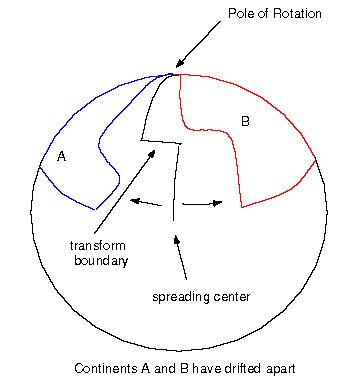
Imagine that you place your hands on a globe with your thumbs tucked
under your palms and your index fingers touching. Now move your hands
apart while keeping the tips of your index fingers in contact. Where
your fingers touch is the pole of rotation. Where your fingers
were is the spreading center. Note that the farther from the pole of
rotation you are, the faster your hands are moving in space, even
though the angular rate of rotation is constant.
The grinding of the plates as they move with respect to one another
is the principle cause of earthquakes and indeed, most earthquakes are
located along plate boundaries:

When new crust forms, it is HOT. Therefore it is less dense, more
bouyant and it "sticks up" higher than the surrounding, older colder
material. This is why ridges are higher than the surrounding crust. As
the oceanic crust is pulled away from the spreading center, it cools and
sinks. Also, the farther from the spreading center, the older the
crust.
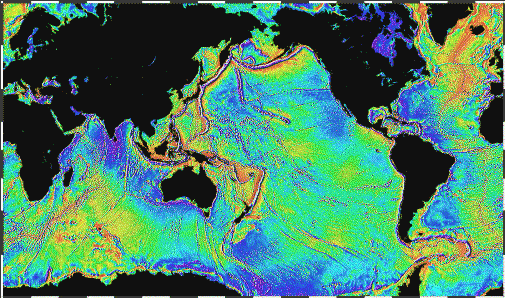
This Global Marine Gravity Map has been sectioned into 16 clickable regions.
Clicking on a given region will produce an expanded view of that portion of the map.
The Earth's field is a great magnet which switches its polarity
often and without warning. As crust forms, it retains a record of the
magnetic field at the time. Thus, the ocean crust forms a gigantic tape
recording of the "music of the Earth":
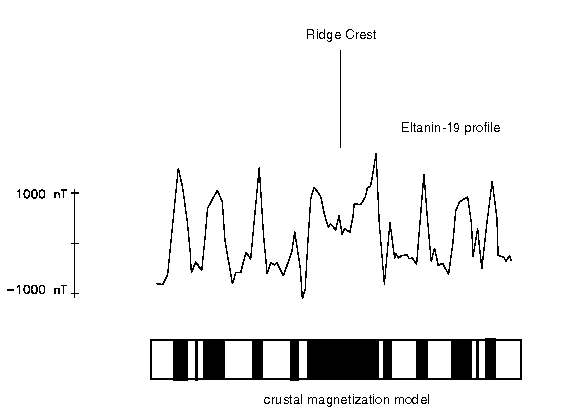
Formation of marine magnetic anomalies at a mid-ocean ridge. Black
and white parts of the oceanic crust (Layer 2) represent normal and reversed magnetizations
respectively. New lithosphere is created at the central ridge and is spreads away. Crust
acquires the magnetization of the prevailing field and blocks of alternate polarity
add or subtract from the ambient Earth's magnetic field resulting in lineated stripes of
anomalously high and low values of the total magnetic field.
The magnetic field averages to approximately the rotational axis of
the Earth. If one plots the location of the magnetic pole as viewed
from a continent that is drifting, that pole appears to move. Thus, the
apparent polar wander paths of continents record continental
drift.
Evidence for the plate tectonic theory
The theory of plate tectonics as described above makes a number of
testable predictions. Here are a few:
Earthquakes
Data from earthquakes can be used to infer the sense of motion
of the plates involved. Plate tectonic theory predicts that the plates
will slide by one another as shown in the figure below.
Without plate tectonics, you might guess that the motion would be the
other way!
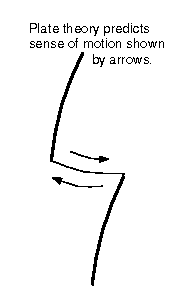
Earthquakes also should mark where the subducting slab is penetrating
the mantle:
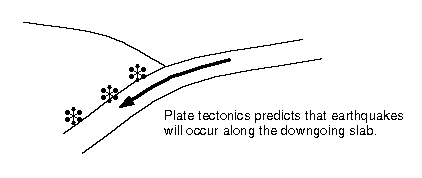
Earthquake data in fact strongly support the plate tectonic
theory.
Seafloor bathymetry
As already mentioned. The new crust is hot and bouyant and it sinks as
it cools. The actual depth of the ocean as a function of age can be
predicted very well from thermal models of a cooling slab in contact
with cold sea water.
Age of the oceans
If the timing of the reversals of the magnetic field is known from other
sources, the age of the sea floor can be determined by matching of the
magntetic anomalies. These anomalies should match the reversal pattern
determined from sediments such as that shown here:
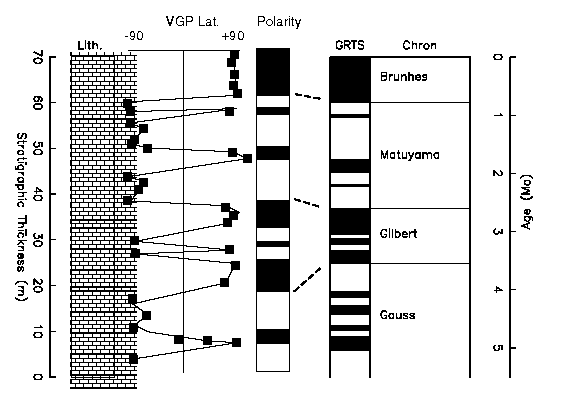
Here is a picture of the age of the sea
floor as determined from magnetic anomalies
(by Dietmar Müller):
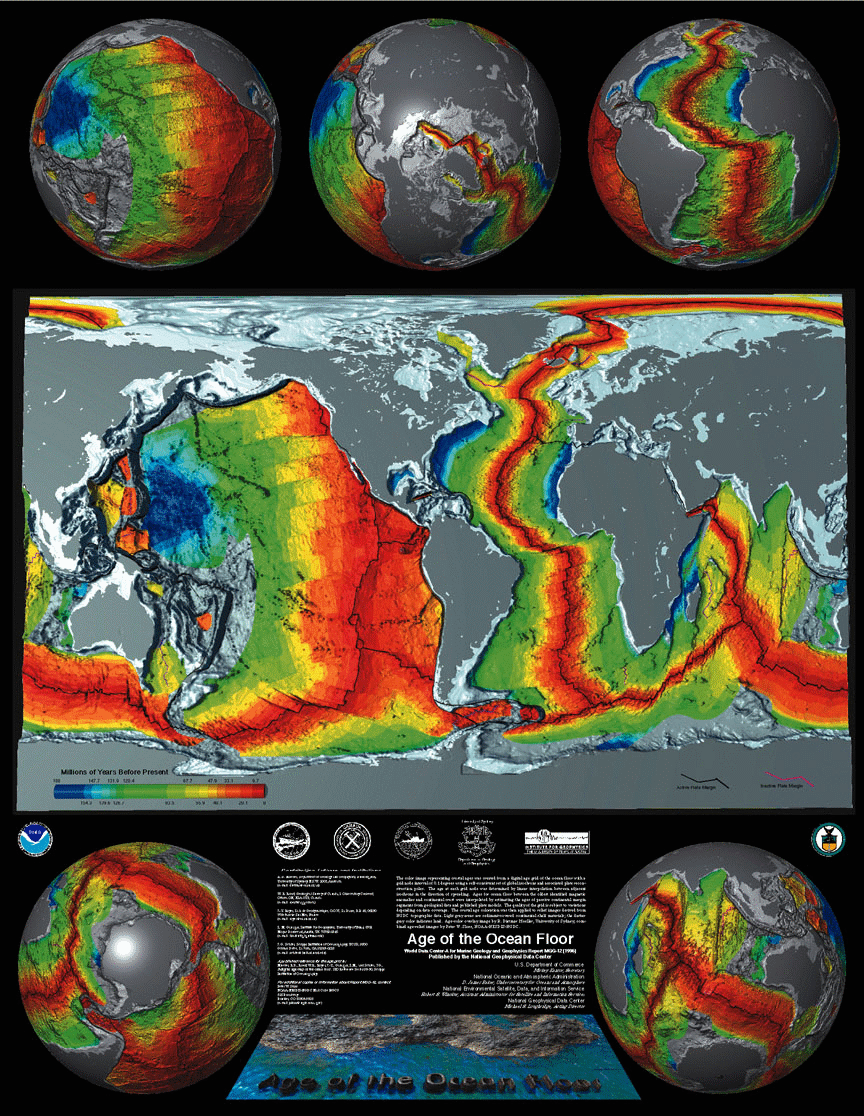 One could then go and drill the seafloor to check if the predicted ages
matched the observed ages. This has been done with the aid of research
drilling ships such as the JOIDES Resolution and
the agreement is excellent.
One could then go and drill the seafloor to check if the predicted ages
matched the observed ages. This has been done with the aid of research
drilling ships such as the JOIDES Resolution and
the agreement is excellent.
Matching coastlines - matching APWP
Many people have had an urge to put Africa and South America together
like pieces of a puzzle. If the idea of continental drift is correct,
doing so should line up the apparent polar wander paths (see
above). Here are the data and I think you will agree, that the APWP for
North America and Europe agree much better after the two have been
slipped back together (right diagram) than in their present coordinates
(left).
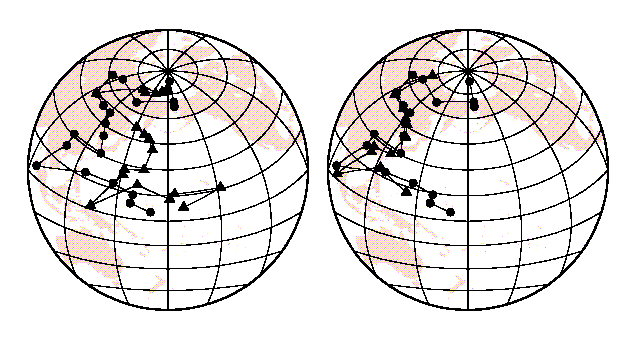
Other evidence
In the early part of this century, a meteorologist named Wegener
presented a large body of evidence in support of continental drift. He
proposed that all the continents were once part of a single huge
continent called Pangaea. He noted among other things that
fossils of plants and land animals that could not travel across a huge
ocen were similar on many of the continents of Pangaea as shown here:

Please check out
this link
for a great summary of continental drift.
Lisa Tauxe
ltauxe@ucsd.edu









